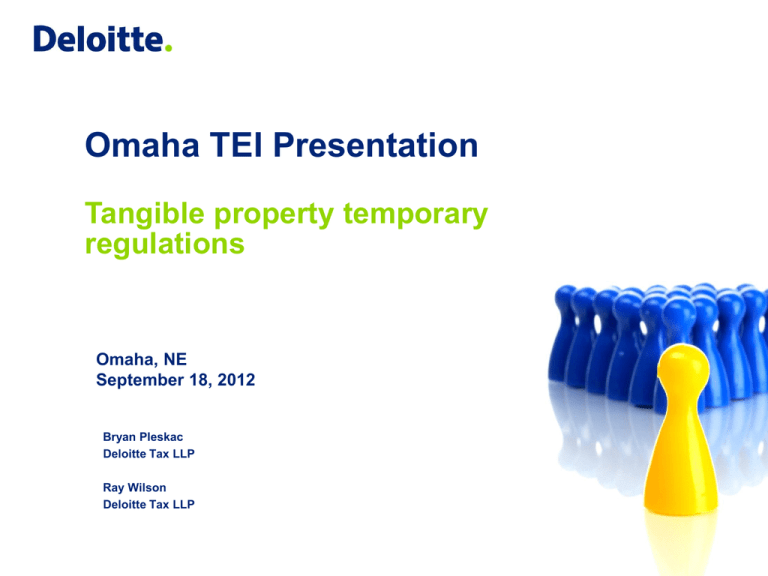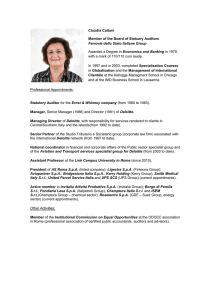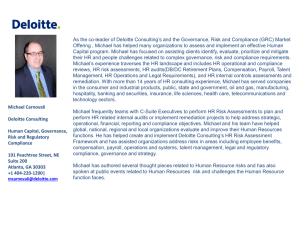
Omaha TEI Presentation
Tangible property temporary
regulations
Omaha, NE
September 18, 2012
Bryan Pleskac
Deloitte Tax LLP
Ray Wilson
Deloitte Tax LLP
Outline
• Effective Dates/Transition Guidance
• Temporary Regulations
– Discussion Areas
• Materials and Supplies
• De Minimus Rule
• Units of property
• Amounts paid to improve property
• Routine maintenance safe harbor
• Buildings
• Disposition, retirements & general asset accounts
• Transition Guidance/LB&I Directive
• Action steps
Copyright © 2012 Deloitte Development LLC. All rights reserved.
Effective Dates/Transition
Guidance
Effective Dates
• Temporary Regulations are generally effective for taxable years
beginning on or after January 1, 2012
– Special rules apply for amounts paid or incurred in taxable years beginning on
or after January 1, 2012 for:
• Materials and supplies
• De minimis rule
• Costs to facilitate
• Transition guidance issued March 7, 2012 (Rev. Proc. 2012-19 and 2012-20)
– Effective for taxable years starting after January 1, 2012
– 19 possible method changes under the guidance
– All automatic changes!
– Must file with 2012 or 2013 return
Copyright © 2012 Deloitte Development LLC. All rights reserved
Temporary Regulations
Temporary Regulations
Discussion Areas
• Materials and supplies
• De Minimus rule
• Amounts paid to improve property
• Buildings
• Retirements, dispositions and general asset account election
Copyright © 2012 Deloitte Development LLC. All rights reserved.
Materials and Supplies – General Rules
• Material and supplies are tangible property used or consumed in the
taxpayer’s operations that is not inventory and is:
– a component acquired to maintain, repair, or improve a unit of tangible
property;
– fuel, lubricants, water, or similar items that are reasonably expected to be
consumed in 12 months or less;
– a unit of property that has an economic useful life of 12-months or less;
– a unit of property with an acquisition or production cost less than $100; or
– property identified in future published guidance
• If the criteria above met, the item is deemed to be a “material or supply”,
and therefore, not subject to capitalization.
• Optional election to capitalize and depreciate the materials and supplies
• Special rules for rotable and temporary spare parts
Copyright © 2012 Deloitte Development LLC. All rights reserved.
Materials and Supplies – Issues and
Considerations
• What you need to consider:
– What has changed?
• Materials and supplies definition has been provided
• Special methods for rotable spare parts
– Current treatment of materials and supplies?
• Timing of deductions - Incidental vs. Non-incidental (e.g. are supplies
tracked?)
• Existence of rotables and current treatment
– Opportunities within the Temporary Regulations
• Expanded definition of materials and supplies (e.g. $100 items)
• Review balance sheet for material and supplies inventories and consider
if these items are tracked for their usage
• Election to capitalize (e.g. NOL preservation)
Copyright © 2012 Deloitte Development LLC. All rights reserved.
De minimis Rule
Requirements
Deduction
limited to
greater of:
• Applicable Financial Statement (“AFS”)
• Written capitalization policy
• Expense in AFS according to written policy
• .1% of tax gross receipts, or
• 2% of depreciation on AFS
Copyright © 2012 Deloitte Development LLC. All rights reserved.
De Minimis Rule - Example
• To be eligible for the de minimis rule, the total aggregate amounts paid and not
capitalized by the taxpayer must be less than or equal to the greater of
$125,000 (0.1 % of its total gross receipts of $125M) or $140,000 (2 % of its
total book depreciation/amortization $7M). Because the taxpayer pays $160,000
for the computers and this amount exceeds $140,000, it may not apply the de
minimis rule to the total amounts paid for the 400 computers.
• To be eligible for the de minimis rule, the total aggregate amounts paid and not
capitalized by the taxpayer must be less than or equal to the greater of
$125,000 (0.1 % of its total gross receipts of $125M) or $140,000 (2 % of its
total book depreciation/amortization $7M). Because the taxpayer pays $160,000
for the computers and this amount exceeds $140,000, it may not apply the de
minimis rule to the total amounts paid for the 400 computers.
• However, if it makes an election to capitalize $20,000, the amounts paid to
acquire 50 of the 400 computers purchased in Year 1, it would not be required
to capitalize the amounts paid to acquire the 350 computers in Year 1.
Copyright © 2012 Deloitte Development LLC. All rights reserved.
De Minimis Rule – Issues and Considerations
• What you need to consider:
– What has changed?
• Previously no rules or guidance on capitalization thresholds; the
temporary regulations now provide that guidance
– Identification of expenses to consider for the de minimis threshold
• Identify trial balance account containing tangible property
• Items qualifying as materials and supplies or repairs and maintenance
(e.g. reduction of expenses for de minimis calculation)
• Items not related to tangible property (e.g. deductible repairs and
services)
– Policy, system updates, and documentation
• Is the policy being followed (e.g. expenditures outside of policy limit
currently deducted)?
• System updates for expenditure tracking on a go-forward basis (e.g.
quantity fields, account mapping, description field assignments, etc.)
• Document accounts and create calculation templates for compliance
workpapers
Copyright © 2012 Deloitte Development LLC. All rights reserved.
Amounts Paid to Improve Property
Determine
the unit of
property
Apply the
improvement
standards
Consider the
routine
maintenance
safe harbor
Copyright © 2012 Deloitte Development LLC. All rights reserved.
Unit of Property
Buildings
•Each building and its structural components is a UoP
•Improvement standards are applied at the building & building system level
Plant Property
•Functional interdependence is relevant
•Discrete and major function standard must be applied
Network Assets
•Based on facts and circumstances or as provided in published guidance
•Functional interdependence test not determinative
Leased Property
•Each building and its structural components (lessor) or the portion of each building subject to the
lease and the structural components associated with the leased portion (lessee)
•Improvement standards are applied to the portion of the building & building systems subject to the
lease (lessee)
Other Property
•Functional Interdependence
•Facts & circumstances
Copyright © 2012 Deloitte Development LLC. All rights reserved.
Amounts Paid to Improve Property
Determine
the unit of
property
Apply the
improvement
standards
Consider the
routine
maintenance
safe harbor
Copyright © 2012 Deloitte Development LLC. All rights reserved.
Amounts Paid to Acquire or Produce Tangible Property Temp. Reg. § 1.263(a)-2T
Capitalize
amounts to:
Does not apply
to:
• Acquire or produce a unit of real or
personal property,
• Defend or protect title to a unit or real or
personal property, or
• Facilitate the acquisition or production
of real or personal property
• Amounts treated as materials and
supplies under Temp. Reg. § 1.162-3T
• Amounts subject to de minimis rule
Copyright © 2012 Deloitte Development LLC. All rights reserved
Amounts Paid to Improve Property
Restoration?
Betterment?
Adaptation?
Capitalizable
Improvement
Copyright © 2012 Deloitte Development LLC. All rights reserved.
Amounts Paid to Improve Property
Betterment
• Corrects a material defect existing prior to the taxpayer’s
acquisition of the UoP or one that arose during the production
of the UoP;
• Results in a material addition (e.g., physical enlargement,
expansion or extension) to the UoP; or
• Results in a material increase in capacity, strength,
productivity, efficiency, quality, or output of the UoP
Restoration
• Repair or replacement of a component of a unit of property and
the taxpayer has properly taken into account the adjusted basis
of the component in realizing gain or loss (including casualty
loss)
• Returns the unit of property to its ordinarily efficient operating
condition if the property has deteriorated to a state of
nonfunctional disrepair
• Rebuilding of the unit of property to a like-new condition after
the end of its class life
• Replacement of a part or a combination of parts that comprise
a major component or a substantial structural part of a unit
of property
Adaptation
• Modification of a unit of property that is not consistent with the
taxpayer’s intended ordinary use of the unit of property at the
time the property was placed in service
Copyright © 2012 Deloitte Development LLC. All rights reserved.
Amounts Paid to Improve Property
• What you need to consider:
– What has changed?
• More clearly defined criteria to determine deductible repairs
– Review prior repairs studies for impact of changes pursuant to the Tangible
Property Regulations
– Review previously claimed repairs and maintenance expenditures (e.g. line
14) deducted for both book and tax purposes
– Review fixed asset ledgers for additional repair and maintenance
reclassification opportunities pursuant to the Temporary Regulations
– System Updates, Documentation, and Policy Changes:
• Updates to capital request forms for tax “unit of property” and tax repairs
requirements (e.g. checklists)
• Provide training sessions to facility managers and engineers to assist in
the identification of tax improvements and repairs
• System updates for units of property, tax only repairs, and documentation
of positions
Copyright © 2012 Deloitte Development LLC. All rights reserved.
Amounts Paid to Improve Property
Determine
the unit of
property
Apply the
improvement
standards
Consider the
routine
maintenance
safe harbor
Copyright © 2012 Deloitte Development LLC. All rights reserved.
Routine Maintenance Safe Harbor – Temp.
Reg. § 1.263(a)-3T(f)
Amount paid is deemed to not improve the unit of property if it is for
the recurring activities that a taxpayer expects to perform as a result
of the taxpayer's use of the UoP to keep the unit of property in its
ordinarily efficient operating condition
• Safe harbor does not apply to buildings or structural components
of buildings (or building systems)
• Routine maintenance is activities that the taxpayer reasonably
expects (at the time the property is placed in service) to perform
more than once during the ADS class life of the UoP
• Consider recurring nature of activity, taxpayer’s experience, manufacturer
recommendations, industry practice, treatment on AFS
• Does not apply to amounts capitalized as betterments,
adaptations, and certain restorations
Copyright © 2012 Deloitte Development LLC. All rights reserved.
Buildings
Unit of
Property
Improvement
standards
applied to
• Each building and its structural components are a unit of property
• Building systems:
• heating, ventilation, and air conditioning systems (HVAC)
• plumbing systems
• electrical systems
• all escalators;
• all elevators
• fire protection and alarm systems
• security systems
• gas distribution systems
• other structural components identified in published guidance
• Building structure, which is defined as the building and its
structural components (other than the sub-systems above)
Copyright © 2012 Deloitte Development LLC. All rights reserved.
Buildings – Issues and Considerations
• What you need to consider:
– What has changed?
• Unit of property for building repairs and retirements re-defined
• Building systems defined
• Application to leased property
– Identification and basis determination:
• Cost segregation studies, Building construction information (e.g. AIA
documents), Other reasonable methods, etc. for basis determination
• Consider effect of reclassification or cost segregation studies on unit of
property
– Policy, System Updates, and Documentation
• Identify building systems during construction and segregate in fixed asset
systems
• Update capital request forms for building system specific questions for
future projects
• Document and create calculation templates for compliance workpapers
to show break out of building systems and basis information
Copyright © 2012 Deloitte Development LLC. All rights reserved.
Dispositions, Retirements & General Asset
Accounts (Temp. Reg. §§ 1.167-8T and
1.168(i)-1T)
Retirement of a structural component of a building is a disposition under IRC
§ 168
Provide rules for accounting for assets to which IRC § 168 applies, and the rules for
determining gain or loss on the disposition of such property
Rules are critical to operation of the restoration improvement standard
General asset accounting and associated elections require affirmative action and must be
considered during the placed in service year of an asset to ensure flexibility when
evaluating the deductibility of future expenditures
Copyright © 2012 Deloitte Development LLC. All rights reserved.
Dispositions and Retirements
• Gain/loss recognized on retirement of a structural component of a
building (now defined as a disposition)
• Loss (but not gain) recognized on the physical abandonment or
transfer to supplies or scrap account (applies to components of
buildings as well)
• Taxpayer may elect to treat a component of a UoP in a general asset
account as a specific asset and deduct undepreciated basis at
disposition
• A taxpayer is not precluded from claiming a repair deduction under the
casualty loss restoration test for a UoP included in general asset
Copyright © 2012 Deloitte Development LLC. All rights reserved.
General Asset Accounts (GAA)
• Elective
• Assets may be grouped into a single GAA if—
– Same depreciation method (cannot combine bonus and non-bonus)
– Same recovery period
– Same convention (must be placed in service in same month, quarter, etc.);
and
– Placed in service in same taxable year
• A single asset can be placed into a GAA
• If GAA elected, no loss on disposition recognized until all assets in GAA
disposed of
– Can elect to treat a component of an asset as a single asset for disposition
purposes
• Structural components of buildings generally defined under section 48 regulations
• Definition of component must be consistently used for all assets in a single GAA
• Election provides flexibility in determining whether to take a loss on a disposition
or possibility a deduction for repairs costs (assuming such costs are not a
capitalizable improvement)
Copyright © 2012 Deloitte Development LLC. All rights reserved.
Retirements, Dispositions & General Asset
Accounts – Issues and Considerations
• What you need to consider:
• What has changed?
– Treatment/timing of real property retirements/dispositions
– Timing for recognition of gains and losses
• Current retirements methodology (e.g. retiring structural components of
buildings) and conformation to Tangible Property Regulations
• Additional retirement opportunities and impact on repair expenditures
(e.g. reverse prior retirements to sustain repair position)
• Application of GAA elections:
– Elect GAA on building property (leased and owned) to minimize
compliance and avoid lost deductions (e.g. allowed or allowable)
– Need for GAA elections for personal property (e.g. different book and tax
units)
Copyright © 2012 Deloitte Development LLC. All rights reserved.
Transition Guidance/LB&I
Directive
Transition Guidance
• Rev. Procs. 2012-19 and 2012-20 issued March 7, 2012
– Automatic consent for method changes to comply with temporary regulations
for taxable years beginning on or after January 1, 2012
• Form 3115s due by extended due date of the return for the tax year of
change
• Temporary regulations cannot be early adopted under this guidance
– Scope limitations waived for first and second tax years beginning after
December 31, 2011
– Taxpayers receive back year audit protection upon filing national office copy
of Form 3115
• National office copy sent to Ogden, UT
– Taxpayers file a single Form 3115 for all concurrent changes under §§
1.162-3T, 1.162-4T, 1.263(a)-1T, 1.263(a)-2T, 1.263(a)-3T
• Special rules may apply for concurrent depreciation changes
• Must take into account § 263A
Copyright © 2012 Deloitte Development LLC. All rights reserved.
Transition Guidance – Common Method Changes
Change to deduct
repairs/maintenance and
change unit of property
for purposes of applying
improvement standards
Change to capitalize
(and if applicable, to
depreciate)
improvements to units of
property
Change to apply de
minimis rule
•
•
Change made with § 481(a) adjustment
Can use statistical sampling to compute § 481(a) adjustment and
support amounts on post-change returns
• Statistical sampling methods must comply with Rev. Proc. 2011-42
•
•
Change made with § 481(a) adjustment
Can use statistical sampling to compute § 481(a) adjustment and
support amounts on post-change returns
• Statistical sampling methods must comply with Rev. Proc. 2011-42
•
Change made with modified § 481(a) adjustment
• § 481(a) adjustment takes into account only amounts paid or incurred
in taxable years beginning on or after January 1, 2012
Copyright © 2012 Deloitte Development LLC. All rights reserved.
Transition Guidance – Common Method Changes
•
Change to dispositions
of buildings and
structural components
Change to make a
general asset account
election for MACRS
property placed in
service in a taxable
year beginning before
January 1, 2012
•
•
Affects determination of gain/loss on disposition and may affect
determination of whether expenditure is a capitalizable
restoration
Change made with § 481(a) adjustment
Can use statistical sampling to compute § 481(a) adjustment and
support amounts on post-change returns
•
Statistical sampling methods must comply with Rev. Proc. 2011-42
• May affect determination of whether expenditure is a capitalizable
restoration
• Change made with § 481(a) adjustment if asset is no longer
owned by the taxpayer as of beginning of year of change
• Change made on a modified cut-off basis if assets are owned
by the taxpayer as of the beginning of the year of change
• Unadjusted depreciable basis and depreciation reserve of asset
as of beginning of year of change accounted for on new method
Copyright © 2012 Deloitte Development LLC. All rights reserved.
LB&I Directive (LB&I-4-0312-004 (3/15/12))
• IRS to discontinue current exams with respect to positions taken on
original returns relating to—
• Whether costs incurred to maintain, replace, or improve tangible property
must be capitalized under IRC § 263(a)
• Correlative issues involving the disposition of structural components of a
building or dispositions of tangible depreciable assets (other than a building
or its structural components)
• Does not apply to exam activity relating to costs for which the IRS has
provided specific guidance separate from the temporary regulations
• For accounting method changes on or after 12/23/2011 for a tax year
beginning before 1/1/2012, exam is to risk-assess the Form 3115
• For taxable years beginning on or after 1/1/2012 and before 1/1/2014,
exam to determine if taxpayer filed method change pursuant to
guidance during scope waiver period
Copyright © 2012 Deloitte Development LLC. All rights reserved.
Action Steps
ASC 740 Considerations
Financial statement
impact
• The temporary regulations are prospective.
• Generally no impact for a financial statement reporting period ending
prior to March 7, 2012.
• Financial accounting treatment depends on taxpayer’s intent to make
the accounting method changes under Rev. Procs. 2012-19 and
2012-20
Rev. Procs. 2012-19
and 2012-20 are critical
in evaluating
unrecognized tax
benefit liabilities
• Rev. Procs. 2012-19 and 2012-20 include automatic consent to
change methods of accounting.
• Rev. Procs. 2012-19 and 2012-20 include waiver of scope limitations
and allow taxpayers to change their methods of accounting while
under examination.
Amounts incurred in
taxable years beginning
on or after January 1,
2012
• Taxpayers may generally begin to account for costs incurred after
12/31/2011 consistent with the temporary regulations if the taxpayers
expect to change their method of accounting pursuant to the
temporary regulations and the revenue procedures.
Copyright © 2012 Deloitte Development LLC. All rights reserved.
Determine how your company will accomplish
the following…
Understand how the definitions of materials and supplies, UoP
improvement, betterment, and routine maintenance affect the way your
business capitalizes or deducts assets
Understand how the de minimis rule might affect your capitalization
threshold
Consider how the favorable rules relating to facilitative costs apply in
your business
Understand whether and to what extent your business currently accounts
for dispositions and what the appropriate method(s) might be under the
temporary regulations
Consider completing an assessment in advance of adopting the
Temporary Regulations to determine potential impact and possible
system limitations
Copyright © 2012 Deloitte Development LLC. All rights reserved.
Contact info
Bryan Pleskac
402 997 7816
bpleskac@deloitte.com
Ray Wilson
612 397 4704
rawilson@deloitte.com
Copyright © 2012 Deloitte Development LLC. All rights reserved.
This presentation contains general information only and Deloitte is not, by means of this
presentation, rendering accounting, business, financial, investment, legal, tax, or other
professional advice or services. This presentation is not a substitute for such professional advice
or services, nor should it be used as a basis for any decision or action that may affect your
business. Before making any decision or taking any action that may affect your business, you
should consult a qualified professional advisor. Deloitte shall not be responsible for any loss
sustained by any person who relies on this presentation.
Copyright © 2012 Deloitte Development LLC. All rights reserved.
About Deloitte
Deloitte refers to one or more of Deloitte Touche Tohmatsu Limited, a UK private company limited by
guarantee, and its network of member firms, each of which is a legally separate and independent entity.
Please see www.deloitte.com/about for a detailed description of the legal structure of Deloitte Touche
Tohmatsu Limited and its member firms. Please see www.deloitte.com/us/about for a detailed description
of the legal structure of Deloitte LLP and its subsidiaries. Certain services may not be available to attest
clients under the rules and regulations of public accounting.
Copyright © 2012 Deloitte Development LLC. All rights reserved.










